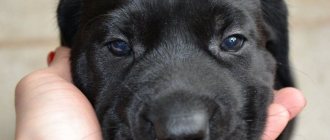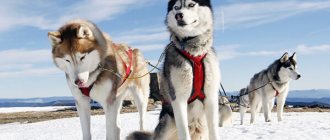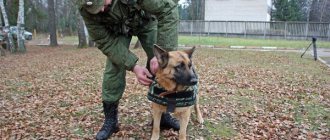If you ask passers-by what breed of Doberman dog it is, you will hear something like: big, angry, aggressive, beautiful, seen in Glucose’s video and on Rosenbaum’s discs.
This is partly true, but if you want to find out what a handsome Doberman he is in real life, then you just need to sit on thematic forums to re-read all the real reviews about the Doberman breed and life stories with it. Modern society is such that everyone wants a small dog that brings more joy than trouble.
Description and characteristics
Doberman is a working breed.
Individuals are characterized by strength, courage, passion, balance, and controllability. Thoroughbred representatives have a narrow muzzle; the cheeks should not be bulging or sagging. The eyes are brown, oval-shaped, medium size. The ears are erect and set high. Ears and tail are docked. Paws are strong, long, straight. The coat is hard, short, and has no undercoat. The color is black or brown. There are tan marks on the cheekbones, eyelids, chest, throat, paws, thighs - on the inside.
The male reaches a height of 67-72 cm, weight 40-45 kg.
Take the Attention Test! Find 10 differences! (click right here!)
Find the answer Are you bothered by some problem or question? Enter “Breed” or “Name of the problem” into the form, press Enter and you will find out everything about the issue that interests you.
The female reaches a height of 62-68 cm, weight 30-35 kg.
pros
The positive qualities of the Doberman are:
- Service and security orientation;
- Devotion;
- Natural intelligence;
- Ability to learn;
- Strength and endurance;
- Universal content;
- Appearance.
The dog will be a vigilant guard. The breed is considered the best of guard dogs. Shows courage and determination in the face of danger. It senses a scent, so it is often used by the police for search activities.
The animal will be devoted to the owner and his family. With proper upbringing, the owner will be regarded as a leader. A small child in a family is regarded as a playmate. The dog will guard the baby, but will not obey the child’s commands.
Thoroughbred individuals are naturally intelligent, capable of learning any commands. A trained dog maintains discipline and obeys its owner. Training is required, otherwise behavior problems are guaranteed.
Dobermans are strong and resilient and can cope with physical stress, which is why they are valued as service dogs.
Possible maintenance in a private or apartment building.
Has an elite appearance and article. The appearance encourages many to get this dog.
Origin of the breed
Doberman is one of the few breeds whose origin is virtually beyond doubt. It appeared at the end of the 19th century. The dogs owe their name to Friedrich Dobermann, who dreamed of creating an ideal service breed, distinguished by its viciousness, fearlessness and endurance.
Initially, however, the breed was called differently - Thuringian Pinscher, and only after the death of Doberman it received the name Doberman Pinscher.
For mating, the ancestors of Rottweilers (“butcher” dogs), German pinschers, greyhounds, Beaucerons, Great Danes and other breeds were used. It is impossible to give exact data, since stud books were not kept. However, breeding work was not successful, since the dogs were characterized by excessive excitability and uncontrollability. Outwardly, the first Dobermans looked like lightweight Rottweilers.
The first exhibition in which the Doberman Pinscher participated was held in 1987 in Erfurt, and in 1899 the first club for fans of this breed was created in Apolda.
In 1949, due to numerous disputes over the origin of the dogs, Doberman Pinschers were turned into Dobermans, removing the prefix “pinscher” from the name.
Today, Dobermans are actively used in the police, search and rescue, search, protective guard, customs services, in a word, wherever their lightning-fast reaction, fearlessness and special flair are required. By the way, the dog Tref, a legend of the detective police of the times of Tsarist Russia, participated in solving 1,500 crimes!
Minuses
The disadvantage of Dobermans is manifested in:
- Stubbornness;
- Aggression;
- Excess - energy;
- Mandatory training;
- Exclusiveness of purpose.
The breed is distinguished by its stubbornness and willfulness. The pet will strive for leadership; males can mark their home territory. The owner's reputation must not be lost, otherwise the dog will become uncontrollable.
Dobermans are temperamental and pugnacious. Ill-mannered individuals have conflicts and will bully other animals and people. During walks, the pet must be muzzled. The dog responds to danger with aggression. When warning, it will not bark, but growl. The animal needs to spend time together with its owner. The dog cannot be kept on a chain, otherwise it will go wild.
Representatives of the breed need activity and physical exercise. The Doberman is low maintenance and requires vigorous play and long walks. The dog will not relieve himself in the litter box; walks are required. This individual will not make a lap dog.
Without training, the animal will pose a danger to others. The guard's innate instincts must be corrected. The puppy must be trained immediately. Dogs of this breed are easy to train and require the attention and time of the owner. The Doberman must be treated with severity, but not with cruelty; the dog can become embittered. Some owners turn to dog handlers for help.
https://dog-care.ru/porody/reyting/doberman-otzyvy-vladeltsev.html
The Doberman is designed for equally strong, strong-willed, energetic, and confident people. Not suitable for the elderly and children who are unable to cope with the pet's temper.
Often people who have failed to raise a pet speak poorly about the breed.
Health, typical diseases
Dobermans, despite the active breeding work that was carried out on them, have good health and do not have many genetic diseases. The life expectancy of representatives of this breed is on average 13-16 years.
As a rule, Dobermans do not suffer from diseases typical of service dogs. Metabolic disorders, epilepsy, and ophthalmological pathologies are diagnosed in rare cases. Hereditary pathologies include:
- dysplasia of the hip and elbow joints;
- intermittent claudication (panostitis);
- Wobbler syndrome (chronic displacement of the cervical vertebrae, dislocations, subluxations);
- von Willebrand-Jurgens syndrome (blood clotting disorder due to platelet pathology);
- hypothyroidism (dysfunction of the thyroid gland due to lack of hormones).
Dobermans sometimes have cardiomyopathy (a pathology of the heart muscle that has lost tone). Main symptoms: decreased stamina, cough, blue skin, apathy. The disease can occur in acute and chronic form. With the first, the risk of death is high, with the second - deterioration of the animal’s condition.
In addition, representatives of this breed are at risk for deadly pathologies - volvulus, gastric torsion. The disease is characterized by the displacement of part of an organ, its incorrect position due to sudden movement while running or during exercise.
Tissues deprived of blood circulation die, leading to sepsis and death. A sad outcome can be prevented only in cases of timely surgical intervention.
Separately, it is worth mentioning the vicious type, subject to genetic mutation. The white variety of Dobermans, which does not meet the standard, has a whole bunch of genetic diseases, among which photophobia and melanoma only open the depressing list.
What you need to know
Before starting to work on the character of his pet, the owner needs to find out what qualities a puppy must have in order to be called well-mannered and obedient. The processes of training and education have a close relationship. Training includes learning to unquestioningly carry out simple commands. You can start it immediately as soon as the puppy appears in the house (regardless of its age) and the equipment and necessary things have been purchased for it. Education involves the formation of a clear hierarchy in the family, an understanding of what the owner’s behavior should be towards the dog.
We cannot ignore everything that a well-mannered puppy and its owners should know:
- If owners want to solve difficulties associated with their pet’s behavior, they must learn the main rules of upbringing. Failure to comply with these principles becomes the main reason for their appearance.
- One of the most important skills for a pet is toilet training outside or in a certain place in the house. The puppy will not be able to deal with these issues on his own. He can acquire this skill only through training. You need to start developing good toilet habits as early as possible. And the more correct the chosen training tactics, the faster you will be able to achieve stable results.
- You need to train your pet from the moment it starts living in your home. At a minimum, he should learn and follow basic commands.
- Puppy owners can face many difficult situations. For example, if a baby fawns over strangers, they begin to fear that he will not be able to become a reliable protector. Or, perhaps, the puppy bites when trying to feed and during play. Other pets may pick up crap from the floor or flatly refuse to listen to you. If you pay attention to different aspects of education, you can solve such problems.
Care
The Doberman is an unpretentious pet. He lives well in an enclosure or in a house. Despite its overall dimensions, the dog does not require much space. If you walk him enough, he will be calm at home and will not misbehave or impose his company. Caring for an adult dog is also easy. Dobermans are distinguished by good health and unpretentious diet. They have short hair, no dog smell, and shedding is moderate.
You need to walk your dog at least 2-3 hours a day. In winter, you need to wear warm overalls, since Dobermans do not have an undercoat and do not tolerate cold well. If the dog lives outdoors, protection from the sun is necessary. And for the winter, the pet must be taken indoors.
Hygiene procedures are the same as for other short-haired dogs. It is necessary to periodically wipe it with a damp cloth and comb it with a stiff brush. After a walk, be sure to wash your pet’s paws and, if necessary, chest and belly. Full bathing is recommended several times a year.
Your pet's eyes and ears require care. They need to be wiped regularly and inspected for inflammation. Otitis often develops in uncropped ears. To prevent the formation of tartar, you need to brush your teeth regularly. It is especially important to monitor the condition of the puppies’ mouths, preventing inflammatory processes.
Nutrition
You need to carefully select food for your Doberman. There have been cases of gastric volvulus due to inappropriate feeding. Suitable nutrition will prevent overeating, but will be able to provide your pet with all the necessary substances. It is best to choose premium or super-premium complete dry food designed for large breeds. It could be:
- Purina® PRO PLAN;
- Royal Canin;
- Hill's;
Dry food should not be mixed with regular food. If the owner chooses natural food, meat should occupy the main place in it. You need to know how much of it an adult pet needs - at least 500 g per day. You should also give vegetables, cereals, fermented milk products, cottage cheese, and boneless fish.
Health
Doberman Pinschers are strong pets; when properly maintained, they live a long time and suffer little illness. Common pathologies of the breed are:
- elbow dysplasia;
- heart rhythm disturbance;
- narcolepsy;
- allergic diseases;
- musculoskeletal injuries.
To avoid illness, you need to regularly take your pet to the veterinarian. Before six months, the puppy must have all its vaccinations. Regularly treat your pet for fleas and ticks. And deworming 4 times a year.
To decide whether to get a dog of this breed, you can watch the video:
The basis of the educational process
How correctly the puppy will be raised depends on the owner’s persistence, the amount of time spent and love for the pupil. There must also be strict control. Just because you love your pet does not mean that he cannot be punished for pampering or trying to eat something harmful from the floor or the ground. The best owner for any dog is a strong, demanding, but kind dad.
There are several important and effective secrets of proper upbringing:
- If the puppy deserves physical punishment, there is no need to make concessions. The type of punishment will have to be applied at the beginning of education. In the future, the dog will wean itself from doing bad things and will know that at the first request it needs to execute the “fu” command. You should not lose sight of the fact that until the age of 3 months, a pet cannot be raised using physical punishment. At a tender age, parenting methods should be extremely careful.
- The baby should receive as many positive emotions as possible from the owner. The pet takes negative emotions and punishment for granted if they are appropriate, and the owner does not forget to praise his pupil. It is worth encouraging the puppy, for example, when he correctly followed the command, went to the toilet in a special place. Many owners pet their dogs even without achievements. If you use this gesture of attention more often, the contact between the owner and the puppy becomes closer.
- If you took a puppy to become a friend, a protector, then you need to take into account that loyalty is the quality of those dogs that consider their owner a member of their pack. Then the dog is really ready to give his life so that you can be saved.
Overly cruel and demanding owners will not be able to raise a reliable protector. This does not mean that you can allow people to sit on your neck. The principle of the golden mean is to initially praise the kids as often as possible, and over time, praise and encouragement with treats for following commands will be needed much less often.
Early socialization is the key to success
Whether it's children, other dogs, or other types of pets, the underlying theme here is that early socialization is the key to success. When a Doberman is a young puppy, everything is interesting to him.
Exposing them to as many situations, people, and other animals as possible will help them become well-rounded adults.
This is especially true for children. When my Doberman was a little puppy, we brought as many children and other dogs as we could to him. He is very used to children petting him, pulling his ears, pulling his ears and worse.
Since all dogs can defend their food, my wife and I used to put our hands in his food bowl while he was eating, forcing him to stop eating and wait for us to remove our hands so he could continue.
He's now almost six years old, weighs about 90 pounds, and kids or anyone else just can't handle him. When it comes to children, he is the most gentle dog I have ever had.
They can tug and pull him as much as they want, and if it's too hard for him, he'll just walk away. Our child can put his hand in the bowl or even directly in his mouth while chewing on his favorite toy and it just won't give him pause.
He will immediately stop eating the food or chewing the toy and wait. I simply cannot stress enough the importance of early socialization for the Doberman.
Take him to the dog park, to family gatherings where there is a big loud group with a lot of people, let the neighborhood kids play with your sweet new puppy.
Just do as much as you can when they are young and you will have a gentle giant when they become adults.
Will moderate severity offend a puppy?
It’s rare that someone manages to raise a dog (even if this happens, not with every pet), using only rewards. For example, these will be treats, praise. For the most part, dog owners are convinced that it is impossible to do without punishment.
If you pay attention to your puppy, play with him, spend a lot of time together, and don’t forget about appropriate praise, then he won’t even remember about strict educational measures. Dogs understand everything well, but it takes time to establish close contact.
Determining your role in the pack
Regardless of its age, the dog perceives the family of its owners as a pack that must have a leader. In her understanding, it is impossible for a pack to survive without a leader. Therefore, to ensure all members survive and achieve a better life, the pet strives to take the place of leader.
Natural instincts make a dog challenge you to see if you are strong enough to deserve to be the leader. The puppy first tries to find out his chances of leadership at approximately 4-6 months of age. For example, he may growl when wiping his paws after a walk or when his owners approach a bowl of food. Sometimes the dog may even “signalize” the bite. There is no need to be afraid of this behavior - this is done to find out who is in charge in the pack. Only a strong leader can ensure survival and protection.
Although the determination of leadership is a natural phenomenon for dogs, this does not mean that coexistence will turn into a struggle for dominance in the family. You just need to always get what you want from your pet. It is important to maintain self-confidence. Dogs do not like weak-willed individuals who do not have their own opinions.
Guard dog instincts
The Doberman Pinscher breed was originally created in the 1800s by a tax collector who needed a dog for personal protection while collecting taxes.
He had many qualities that he believed were ideal for a guard dog. As a result, Dobermans have a natural instinct to protect those they bond with.
However, modern Dobermans are much gentler than their counterparts many generations ago. Breeders have done a good job of breeding out some of the aggressive traits found in these dogs, even just a few decades ago.
They are now great family companions who love their owners, they are affectionate and love to cuddle but will certainly protect you.
Simple conclusions for the owner
To raise a well-mannered and obedient puppy, you need:
- Engage with him in studying and executing commands.
- Set clear and understandable rules.
- Solve problems that arise during the education process.
- Insist on.
- Don't be afraid to use physical punishment.
- Remember that you can never have too many positive emotions and games.
- Show your dog confidence in his abilities.
- Believe that if you work and put in a lot of effort, success will come.
And the most important thing to always remember is not to worry about small failures or difficulties. After just a short period of time, you will be surprised by the positive changes in the character of your pupil. You just need to work while maintaining optimism and a good mood.
Exercise requirements
One of the most important aspects when deciding whether a Doberman is right for your family is to consider how active your family is. These dogs need a lot of exercise to keep them happy and relieve stress.
If your family is constantly walking or biking, hiking, or just running around playing outdoor games, then this would be a great dog for you. In fact, you may find that your Doberman will outplay your children and tire them out. If your family is less active and stays at home a lot, this may not be the best choice.
There are many dog breeds that are bred as companion dogs and they will be completely happy to spend hours relaxing on your lap in the house. The Doberman Pinscher is not one of them.
What should a novice trainer remember?
To prevent training from turning into torture, you need to consider a few more points:
- Any workout can be made easier. To do this, you need to take your pet for a good walk in advance. A tired, running dog will be less distracted. This means the effect will be greater. According to experienced owners, active walking makes working with the animal several times easier.
- Each command is spoken only once. They cannot be duplicated. The dog quickly grasps, if he understands that the owner can repeat the same thing several times, then he will stop performing the technique the first time.
- There must be pauses between teams. When practicing, for example, “near”, “lie down”, “fetch”, you need to give the dog time to take a breath. 5-10 seconds will be enough. If you do not pause, the dog may simply become confused.
- It's important to change the sequence. During training, it is better to practice all techniques separately. If the dog gets used to doing everything in order, nothing good will come of it in the end. Unless he develops a reflex. That, for example, after “to me” you need to “sit.” The dog must master commands in any sequence.
- You cannot overload your student. Too intense training can harm your four-legged friend. We must always keep in mind that a dog is a living creature. She may have some pain. Or not being in the mood to study.
An already trained dog is able to perfectly carry out commands under any conditions. But we must keep in mind that your pet may get tired.
- Sometimes students, like ordinary schoolchildren, “run away from class.” They may be distracted by a nearby cat or other dog. This can be avoided if you are more careful about exposure. Train her on a long leash. This will allow you to catch up with the “mischievous person”, even if he runs fast. A leash with a carabiner for 3-5 meters is suitable. Often such a leash is just needed for endurance and training to pick up “goodies” from the floor.
- “Mass” training is not allowed. Only the dog's owner should act as a trainer. The dog must obey all family members. And pets must master the basic principles of raising an animal. But at the training itself there are only two people: the owner and his pupil. Otherwise, the dog will be constantly distracted.
- Sometimes during training it is worth pausing. It happens that the dog looks scared. He follows commands, but seems to doubt the correctness of his actions. The reason is usually that the owner was too strict and overdid the load. In such cases, you need to get the dog to fulfill the simplest command for him, and then generously praise him. More than usually. The dog, seeing that the owner approves of him, will begin to perform the exercises better. You can even play with the dog or take it for a walk.
- To develop the ideal execution of techniques, they need to be studied systematically, gradually. It is necessary to teach your pet to follow commands in any conditions. Start with perfect obedience in a calm place, gradually adding “stimulants”. They can be created artificially. For example, scattering treats. Or invite a friend to walk past your training place at a certain time. You can come up with “irritants” yourself or read reviews from experienced owners.
Doberman training
It is best to entrust dog training to professionals (at least 2 times a week). If you are ready to take on the responsibility of preparing your dog for life in society, make sure that the animal receives the necessary physical activity in a wide variety of exercises - the same types of activity tire the animal and make it bored.
You can create a whole training program, alternating between playing with a ball and a puller and overcoming obstacles - barriers, tunnels, slides, etc. Such exercises will work on the development of all muscle groups in the dog and will not allow him to be distracted by other things.











